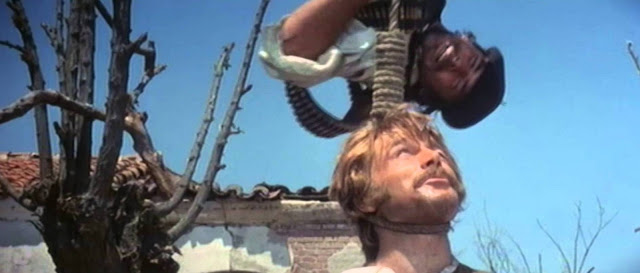Acid Westerns: Compañeros (1970)
Depending on how contrary I am feeling, I sometimes think Sergio Corbucci made better Spaghetti Westerns than Sergio Leone. Sure, the latter filmmaker made movies that were at once delightfully pulpy and also borrowed art house tricks (especially lifting from Akira Kurosawa, one of the finest filmmakers who ever lived.)
But Ridiculous Theater founder Charles Ludlam once described his work as "Theater Without the Stink of Art," and I think that's what we get from Corbucci. He was responsible for the runaway international hit "Django," which inspired seemingly every Spaghetti Western to rename themselves and pretend to be a "Django" sequel (and obviously also inspired Quentin Tarantino). He was also responsible for the little-scene, exceptionally bleak "The Great Silence," which, with its snowbound setting, likely influenced every subsequent Western set in the snow.
Corbucci has all the manic verve of Leone but seeming without pretension — his movies delight in sloppy wildness, and "Compañeros" displays an almost cartoon sensibility. And while Corbucci's politics seem left-leaning, they are cut through with a breathtaking pessimism that, in "Compañeros" in particular, seems very much a product of the Acid Era.
The film is properly an examples of a sub-genre of Westerns called Zapata Westerns, set during the Mexican Revolution of 1910-20. There weren't many of these made in American — with "Viva Zapata!," starring Marlon Brando, being a notable exception. But they were popular in Mexico and Italy, and in the 60s and 70s Italian directors increasingly used them as a way to explore the revolutionary spirit of the 60s.
Quickly, the plot of "Compañeros" has a Swedish arms dealer (Franco Nero) and a revolutionary Mexican peasant (Tomas Milian) join forces to free a pacifist professor who is being held captive at Fort Yuma in California. Neither are good men, although Nero at least seems to be fun, grinning throughout the film even as he coolly explains he absolute lack of a moral center.
The peasant, in the meanwhile, is part of a group of bandits who have hijacked the revolution for their own purposes. At the start of the film, Nero enters a small Mexican village that has been the site of a psychotic amount of bloodshed as the bandits have killed every representative of government; these scenes come close to "El Topo" in their hallucinogenic representation of mass bloodshed. The bandits are in the process of killing actual local revolutionaries when Nero shows up, and what follows is a delirious roadtrip to California.
It does not help that waiting along the way is Jack Palance as a bounty hunter. Palance smokes weed, giggles a lot, and carries a hawk on one arm; he is surrounded by a coterie of weird-looking Western bad men.
A lot of the film is given over to dazzlingly filmed, vaguely absurd set pieces, but the film carefully details a transformation on the part of our amoral heroes: Once they locate the professor, played with superb weariness by Fernando Rey. The film treats his pacifism as impossible but noble, and both the arms dealer and the peasant grow to respect him.
The film never treats the professor as the butt of a joke, and will pause occasionally to allow him an explicitly Communist speech in which he denounces nationalism but supports national self-identification, including the right of Mexicans to make and benefit from Mexican products. There is even a "One Tin Soldier" moment when a safe is opened and reveals its treasure: symbols of the indigenous wealth of Mexico.
By the end of the film, our heroes have become genuinely revolutionary, charging to the defense of the student rebels against an enormous oncoming army while Ennio Morricone's energetic, ratatat theme song plays. The ending is unambiguously uplifting — it's filmed and presented as heroic — but narratively ambiguous, as it seems likely our heroes have chosen suicide.
Additionally, by this time the film has explicitly rejected pacifism, noble thought it might consider the notion, in favor of violent revolution. Despite this being a movie made by Italians, filmed in Spain, and set in Mexico, this is very much what was happening in American politics as we exited the 60s, with groups such as the Weather Underground turning increasingly to campaigns of violence to pursue their political aims.
It's a bit odd to see a film of the era celebrate violent student activism, largely represented here by the enormously charismatic actress German actress Iris Berben. It's odd knowing how this activism played out, which was not well (the Weather Underground, as an example, largely blew themselves up, went to jail, or went into hiding to avoid jail). But it's an oddness created by hindsight, and there is something invigorating about seeing a film from a time that actually had hope for student activism and for revolution.
The film is ambiguous about the future of this sort of activism, yes, but it also represents it as transforming two men who, in any other film, would be the villains. That's an awfully big story to tell in a film that is so relentlessly daffy and eager for fun, but this sensibility doesn't dull the character's transformation, but sharpens it.
We want them to be good people, because, despite their profound lack of principles, they're fun to be around. And the film never makes fun of people for believing the world can be better, or for finding that belief to be revolutionary.



Comments
Post a Comment